THE STORY OF OUR VILLAGE HALL
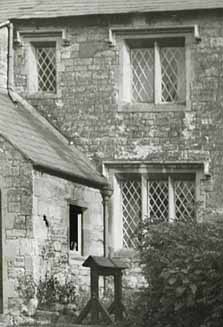 Background
A few of
the old-timers in the village will still refer to our Village Hall in Stoke Road
as 'The Old School'. The building still presents to the street a hint of its
earlier form - the modest ornamental lintels over the upstairs front windows. It
was re-built in that style in c.1800, after the Great Fire of
1798. It was set
back from the roadside with probably three similar upstairs windows and two
large windows with a central door for the ground floor. To the right of the
front door was a freshwater well in the tiny front yard - in fact the well was
not filled in until about 1955. This building served as
the village school until 1913 when the new school was finished at Elm Tree
Corner. It was open in particular to all children excluding the 'babies', ie. 4
and 5 year olds and excluding by family choice most children of Baptist faith.
The building acquired its prominent gable extending outwards towards the
roadside in 1861. The enlargement and the provision of the large gable window
must have improved conditions for the pupils and teachers. Even with the large
window there were times in the winter c.1905 when "the lamps were lit all
day".
Background
A few of
the old-timers in the village will still refer to our Village Hall in Stoke Road
as 'The Old School'. The building still presents to the street a hint of its
earlier form - the modest ornamental lintels over the upstairs front windows. It
was re-built in that style in c.1800, after the Great Fire of
1798. It was set
back from the roadside with probably three similar upstairs windows and two
large windows with a central door for the ground floor. To the right of the
front door was a freshwater well in the tiny front yard - in fact the well was
not filled in until about 1955. This building served as
the village school until 1913 when the new school was finished at Elm Tree
Corner. It was open in particular to all children excluding the 'babies', ie. 4
and 5 year olds and excluding by family choice most children of Baptist faith.
The building acquired its prominent gable extending outwards towards the
roadside in 1861. The enlargement and the provision of the large gable window
must have improved conditions for the pupils and teachers. Even with the large
window there were times in the winter c.1905 when "the lamps were lit all
day".
The school was a Church-of-England school but had a
heritage which originates in 1504. The last of the Wakes resident in the
village, Roger Wake, left an endowment upon his death of £11 per year to
provide a "Grammar School and to attract a teacher of quality such as a
Graduate of Oxford". The charter was to teach children to read and write,
to learn certain scriptures, in Latin, and provide a church choir and welcome
"as
many poor children, as brought to the school, who should be taught alongside the
paying scholars". Rather unwisely, the endowment trust was set up to
provide a fixed amount of money each year, before tax, and by the 1700's the
school had degenerated financially into an ordinary village school and had been
taken over by the Church, the headmasters being a succession of curates or
rectors. By around 1900, the school was managed by a committee of managers made
up from the Board of Ratepayers, the Clergy and officials of the Northampton
Education Authority. Under this regime, the school was designated Blisworth
(Endowed School No. 20) and most teachers by then were subject to national
certification. The school building had become, at some time in the distant past,
the property of the Diocese of Peterborough.
The original location of the endowed school is not
known for certain. At a time before the Great Fire, for example 1750, it is
known that the school building occupied the same space as it does now plus
around 4 yards more in the direction of the centre of the village. Next to the
building was the freehold land of J. Westley senior. He had a house which
spanned his frontage on the Stoke Road and behind it there was a bake-house and
paddock. The fire destroyed maybe a dozen houses including Westley's bake-house,
his house and the school building. In a moment of alacrity, Westley purchased
the 4 yards mentioned above from the church for £40. This was a generous sum
which allowed the church to quickly rebuild the school. In turn, the extra land
allowed Westley to build a house of exaggerated narrowness end-on to the road
thus allowing access to a rebuilt bake-house. The narrow house was built in
1799, just before the new school, and was not demolished until the major housing
developments of the 1960's. (See Stoke Road,
Demolition
and Bacon Factory sections).
The Quest for a Village Hall There
is a Blisworth Parish Council minute in June 1938 acknowledging that there
should be a village hall. Attention was turned to the small building in Stoke
Road directly opposite the old school. This building was put up in 1874 to
accommodate the infants (the 'babies') at a time when the main school was
becoming over-crowded. Due to the railways and mining, the village was expanding
rapidly. By 1913, or just afterwards, the infants were moved into the new school
at Elm Tree Corner. Afterwards, the building, still owned by the Diocese of
Peterborough, was "warmed with a good fire to serve as a quiet
retreat" for the working men of the village. It became known as the Mens
Institute or "Stute". During WWII the building was used by the Army
Cadets, who also had a shed near the Northampton Road (in Bonsor's field).
After WWII the building was used as a youth club having been offered
unsuccessfully to the Girl Guides for their sea-ranger meetings. The disused old school was maintained less well. It accommodated Church-of- England Sunday School meetings but little else. It seems odd that the parish
council should think the much smaller of the two buildings as worthy of being a
village hall. Anyway, by 1954, the Stute was conveyed from the Diocese of
Peterborough to a Village Hall Trust whose trustees were two Blisworth Parish
councillors and a solicitor. In around 1963 the building was sold to Frank
Freeston and the trustees banked £1000.
Going by the contents of the parish council minutes,
attention on the need for a Village Hall seemed to cool in favour of an
ever-mounting push to have some good playing fields. By Len Piggott's account,
the old Parish Field (for decades held by Northamptonshire CC - Towcester
division) was finally bought by the Parish Council, probably for very little,
and some of the banked £1000 was used to level, seed and equip a new playing
field. The measures were made parochially "legal" by merging the
Village Hall Trust and the Playing Fields Association into one body of trustees
- with a charity status - this being achieved in roughly 1965.
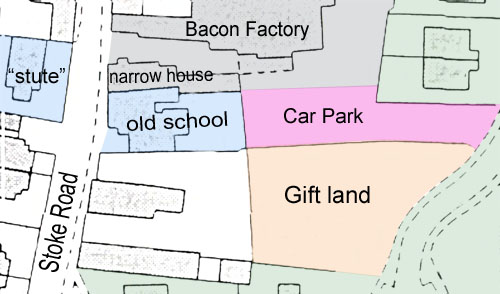 Westley's narrow house and the long paddock behind it
was bought in 1923 by the British Bacon Company. On this site they ran a smelly
slaughterhouse until November 1960 when the company (unwisely) put in a planning
application to raze the buildings and create a modern slaughterhouse facility
there, combining their business which was being closed in Campbell Square in
Northampton. The row that ensued saw them established instead on a green field
site next to Burbidge's garage on the Northampton Road - well away, at last,
from the village. Thankfully there was a wonderful collateral: the new factory
was the last straw loaded onto the village sewage system which duly had to be
re-established on the banks of the River Nene.
Westley's narrow house and the long paddock behind it
was bought in 1923 by the British Bacon Company. On this site they ran a smelly
slaughterhouse until November 1960 when the company (unwisely) put in a planning
application to raze the buildings and create a modern slaughterhouse facility
there, combining their business which was being closed in Campbell Square in
Northampton. The row that ensued saw them established instead on a green field
site next to Burbidge's garage on the Northampton Road - well away, at last,
from the village. Thankfully there was a wonderful collateral: the new factory
was the last straw loaded onto the village sewage system which duly had to be
re-established on the banks of the River Nene.
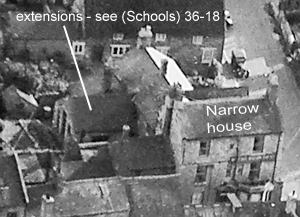 In the late 1960's, not only the bacon factory paddock
but a slice of land attached to Crieff House and the bulk of the land
associated with Home Farm were all being ear-marked for development. The narrow
house next to the, by then, derelict old school was torn down in April 1972 as were a few
other houses fronting onto Stoke Road. Then, at last, in Nov 1974, the old school was seen as a
potential village hall but only after rumours had circulated that the church was
intending to sell it off. The company, Buswell's, was approached and
they gave to a councillor a verbal undertaking that a square of land behind the
old school would be given to the village - to be associated with a vaguely
perceived community centre. It was lucky they were still in the
parish, for someone had to rush to get them to put this in writing so that KG
Lawrence Ltd., the housing developers, had no choice but to leave the patch of ground.
The patch was consistently referred to the 'Buswell Play Area' for many years,
in honour of a promise by the council to associate the name of Buswell, but the
practice has lapsed and some seem keen to call it the village green. In
1973, Mrs. Erichsen arranged to have five trees planted in the play area in
memory of her husband. There are no trees there now.
In the late 1960's, not only the bacon factory paddock
but a slice of land attached to Crieff House and the bulk of the land
associated with Home Farm were all being ear-marked for development. The narrow
house next to the, by then, derelict old school was torn down in April 1972 as were a few
other houses fronting onto Stoke Road. Then, at last, in Nov 1974, the old school was seen as a
potential village hall but only after rumours had circulated that the church was
intending to sell it off. The company, Buswell's, was approached and
they gave to a councillor a verbal undertaking that a square of land behind the
old school would be given to the village - to be associated with a vaguely
perceived community centre. It was lucky they were still in the
parish, for someone had to rush to get them to put this in writing so that KG
Lawrence Ltd., the housing developers, had no choice but to leave the patch of ground.
The patch was consistently referred to the 'Buswell Play Area' for many years,
in honour of a promise by the council to associate the name of Buswell, but the
practice has lapsed and some seem keen to call it the village green. In
1973, Mrs. Erichsen arranged to have five trees planted in the play area in
memory of her husband. There are no trees there now.
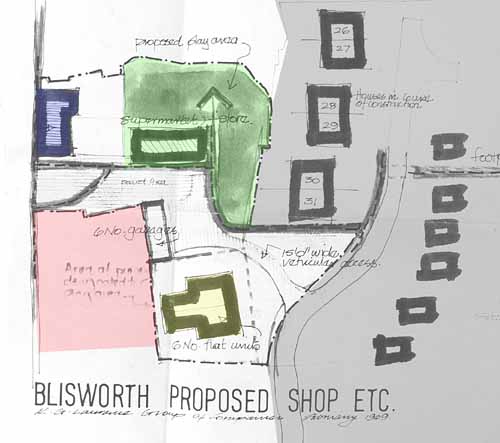 As it turned out,
the patch was not directly behind the old school, for reasons unclear.
Furthermore, it
was not large enough and another strip was needed. It had to be bought from KG
Lawrence Ltd. to provide a car park for an as yet nonexistent village hall. None of
this arranging would have been fruitful if the Diocese of Peterborough had not
agreed to sell the old school building. They actually gave the Parochial Church Council, as
default trustees, a first refusal since it seemed that a Village Hall could
easily be managed by such a group. In the opinion of many it has become more politically
correct for the church not to run the
administration of a community facility - so luckily, the P.C.C.
did relinquish its interests at that early time. In the third quarter of 1975, the old school
officially became the property of the merged association: Village Hall &
Playing Field Association, which is on record as acknowledging that the Diocese
of Peterborough had helped enormously by asking such a small sale price. The
map two paragraphs further up shows what was finally decided. The picture
inset in this paragraph shows what the developers had suggested in response to
some people calling to save the cottages fronting on the Stoke Road
(blue). Note how late this was going on - the greyed area of Eastfield was
already built and occupied. New houses in some sort of "high
rise" format (pale yellow) were suggested behind the old school (pink) and
a supermarket and play area (green) was squeezed in - this was obviously wisely
rejected without referring to residents.
As it turned out,
the patch was not directly behind the old school, for reasons unclear.
Furthermore, it
was not large enough and another strip was needed. It had to be bought from KG
Lawrence Ltd. to provide a car park for an as yet nonexistent village hall. None of
this arranging would have been fruitful if the Diocese of Peterborough had not
agreed to sell the old school building. They actually gave the Parochial Church Council, as
default trustees, a first refusal since it seemed that a Village Hall could
easily be managed by such a group. In the opinion of many it has become more politically
correct for the church not to run the
administration of a community facility - so luckily, the P.C.C.
did relinquish its interests at that early time. In the third quarter of 1975, the old school
officially became the property of the merged association: Village Hall &
Playing Field Association, which is on record as acknowledging that the Diocese
of Peterborough had helped enormously by asking such a small sale price. The
map two paragraphs further up shows what was finally decided. The picture
inset in this paragraph shows what the developers had suggested in response to
some people calling to save the cottages fronting on the Stoke Road
(blue). Note how late this was going on - the greyed area of Eastfield was
already built and occupied. New houses in some sort of "high
rise" format (pale yellow) were suggested behind the old school (pink) and
a supermarket and play area (green) was squeezed in - this was obviously wisely
rejected without referring to residents.
The refurbishment project was handed to the Parish
Council to manage as they had the requisite legal clout. After costly
alterations the building was provided with two upstairs committee rooms and a
large hall with kitchen facilities at the rear. These were not alterations for
the amateur; two very large steel girders were installed to support the
committee room level and the building's rear wall. The untidy brick extensions
on the back of the old school were demolished and much ironstone was dug out to
make room for the large flat-roofed extension that was needed to accommodate the
60 foot
length of the main hall. In 1975 the projected costs were expected to be up to £20,000
according to Robin Philtrip who suggested the village needed to raise some
£3000 to £5000 in order to get the project started - "we would all
happily pay £3 to £4 for a good night out so why not pay that just the once,
for the village, to have the venue for functions in future". Such
sentiments worked and it was not long before the conversion could start.
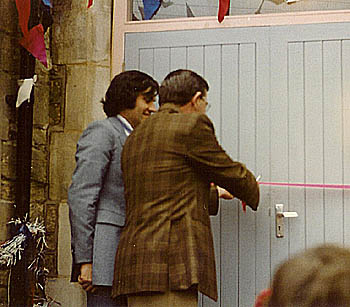 When finished in 1978, the building was handed back to the charity association. This event was
40 years after first recorded mention of a need for a village
hall. It was, of course, the doubling of the number of households in the
parish in the 1960 and 70s that had supplied the driving force. The picture here
shows in September 1978, the PC chairman Robin Philtrip and clerk Tim Rogers
'opening' the new hall by cutting the tape.
When finished in 1978, the building was handed back to the charity association. This event was
40 years after first recorded mention of a need for a village
hall. It was, of course, the doubling of the number of households in the
parish in the 1960 and 70s that had supplied the driving force. The picture here
shows in September 1978, the PC chairman Robin Philtrip and clerk Tim Rogers
'opening' the new hall by cutting the tape.
A building of this type, with a 200 year-old ridge roof
of 'imported' slate, is bound to have bouts of expensive repairs but it does
contribute to Blisworth's distinction. Recent repair projects include the
restoration of the large gable window. A forthcoming problem to solve is the
provision of adequate facilities for the disabled.
 Background
A few of
the old-timers in the village will still refer to our Village Hall in Stoke Road
as 'The Old School'. The building still presents to the street a hint of its
earlier form - the modest ornamental lintels over the upstairs front windows. It
was re-built in that style in c.1800, after the Great Fire of
1798. It was set
back from the roadside with probably three similar upstairs windows and two
large windows with a central door for the ground floor. To the right of the
front door was a freshwater well in the tiny front yard - in fact the well was
not filled in until about 1955. This building served as
the village school until 1913 when the new school was finished at Elm Tree
Corner. It was open in particular to all children excluding the 'babies', ie. 4
and 5 year olds and excluding by family choice most children of Baptist faith.
The building acquired its prominent gable extending outwards towards the
roadside in 1861. The enlargement and the provision of the large gable window
must have improved conditions for the pupils and teachers. Even with the large
window there were times in the winter c.1905 when "the lamps were lit all
day".
Background
A few of
the old-timers in the village will still refer to our Village Hall in Stoke Road
as 'The Old School'. The building still presents to the street a hint of its
earlier form - the modest ornamental lintels over the upstairs front windows. It
was re-built in that style in c.1800, after the Great Fire of
1798. It was set
back from the roadside with probably three similar upstairs windows and two
large windows with a central door for the ground floor. To the right of the
front door was a freshwater well in the tiny front yard - in fact the well was
not filled in until about 1955. This building served as
the village school until 1913 when the new school was finished at Elm Tree
Corner. It was open in particular to all children excluding the 'babies', ie. 4
and 5 year olds and excluding by family choice most children of Baptist faith.
The building acquired its prominent gable extending outwards towards the
roadside in 1861. The enlargement and the provision of the large gable window
must have improved conditions for the pupils and teachers. Even with the large
window there were times in the winter c.1905 when "the lamps were lit all
day". Westley's narrow house and the long paddock behind it
was bought in 1923 by the British Bacon Company. On this site they ran a smelly
slaughterhouse until November 1960 when the company (unwisely) put in a planning
application to raze the buildings and create a modern slaughterhouse facility
there, combining their business which was being closed in Campbell Square in
Northampton. The row that ensued saw them established instead on a green field
site next to Burbidge's garage on the Northampton Road - well away, at last,
from the village. Thankfully there was a wonderful collateral: the new factory
was the last straw loaded onto the village sewage system which duly had to be
re-established on the banks of the River Nene.
Westley's narrow house and the long paddock behind it
was bought in 1923 by the British Bacon Company. On this site they ran a smelly
slaughterhouse until November 1960 when the company (unwisely) put in a planning
application to raze the buildings and create a modern slaughterhouse facility
there, combining their business which was being closed in Campbell Square in
Northampton. The row that ensued saw them established instead on a green field
site next to Burbidge's garage on the Northampton Road - well away, at last,
from the village. Thankfully there was a wonderful collateral: the new factory
was the last straw loaded onto the village sewage system which duly had to be
re-established on the banks of the River Nene. In the late 1960's, not only the bacon factory paddock
but a slice of land attached to Crieff House and the bulk of the land
associated with Home Farm were all being ear-marked for development. The narrow
house next to the, by then, derelict old school was torn down in April 1972 as were a few
other houses fronting onto Stoke Road. Then, at last, in Nov 1974, the old school was seen as a
potential village hall but only after rumours had circulated that the church was
intending to sell it off. The company, Buswell's, was approached and
they gave to a councillor a verbal undertaking that a square of land behind the
old school would be given to the village - to be associated with a vaguely
perceived community centre. It was lucky they were still in the
parish, for someone had to rush to get them to put this in writing so that KG
Lawrence Ltd., the housing developers, had no choice but to leave the patch of ground.
The patch was consistently referred to the 'Buswell Play Area' for many years,
in honour of a promise by the council to associate the name of Buswell, but the
practice has lapsed and some seem keen to call it the village green. In
1973, Mrs. Erichsen arranged to have five trees planted in the play area in
memory of her husband. There are no trees there now.
In the late 1960's, not only the bacon factory paddock
but a slice of land attached to Crieff House and the bulk of the land
associated with Home Farm were all being ear-marked for development. The narrow
house next to the, by then, derelict old school was torn down in April 1972 as were a few
other houses fronting onto Stoke Road. Then, at last, in Nov 1974, the old school was seen as a
potential village hall but only after rumours had circulated that the church was
intending to sell it off. The company, Buswell's, was approached and
they gave to a councillor a verbal undertaking that a square of land behind the
old school would be given to the village - to be associated with a vaguely
perceived community centre. It was lucky they were still in the
parish, for someone had to rush to get them to put this in writing so that KG
Lawrence Ltd., the housing developers, had no choice but to leave the patch of ground.
The patch was consistently referred to the 'Buswell Play Area' for many years,
in honour of a promise by the council to associate the name of Buswell, but the
practice has lapsed and some seem keen to call it the village green. In
1973, Mrs. Erichsen arranged to have five trees planted in the play area in
memory of her husband. There are no trees there now. As it turned out,
the patch was not directly behind the old school, for reasons unclear.
Furthermore, it
was not large enough and another strip was needed. It had to be bought from KG
Lawrence Ltd. to provide a car park for an as yet nonexistent village hall. None of
this arranging would have been fruitful if the Diocese of Peterborough had not
agreed to sell the old school building. They actually gave the Parochial Church Council, as
default trustees, a first refusal since it seemed that a Village Hall could
easily be managed by such a group. In the opinion of many it has become more politically
correct for the church not to run the
administration of a community facility - so luckily, the P.C.C.
did relinquish its interests at that early time. In the third quarter of 1975, the old school
officially became the property of the merged association: Village Hall &
Playing Field Association, which is on record as acknowledging that the Diocese
of Peterborough had helped enormously by asking such a small sale price. The
map two paragraphs further up shows what was finally decided. The picture
inset in this paragraph shows what the developers had suggested in response to
some people calling to save the cottages fronting on the Stoke Road
(blue). Note how late this was going on - the greyed area of Eastfield was
already built and occupied. New houses in some sort of "high
rise" format (pale yellow) were suggested behind the old school (pink) and
a supermarket and play area (green) was squeezed in - this was obviously wisely
rejected without referring to residents.
As it turned out,
the patch was not directly behind the old school, for reasons unclear.
Furthermore, it
was not large enough and another strip was needed. It had to be bought from KG
Lawrence Ltd. to provide a car park for an as yet nonexistent village hall. None of
this arranging would have been fruitful if the Diocese of Peterborough had not
agreed to sell the old school building. They actually gave the Parochial Church Council, as
default trustees, a first refusal since it seemed that a Village Hall could
easily be managed by such a group. In the opinion of many it has become more politically
correct for the church not to run the
administration of a community facility - so luckily, the P.C.C.
did relinquish its interests at that early time. In the third quarter of 1975, the old school
officially became the property of the merged association: Village Hall &
Playing Field Association, which is on record as acknowledging that the Diocese
of Peterborough had helped enormously by asking such a small sale price. The
map two paragraphs further up shows what was finally decided. The picture
inset in this paragraph shows what the developers had suggested in response to
some people calling to save the cottages fronting on the Stoke Road
(blue). Note how late this was going on - the greyed area of Eastfield was
already built and occupied. New houses in some sort of "high
rise" format (pale yellow) were suggested behind the old school (pink) and
a supermarket and play area (green) was squeezed in - this was obviously wisely
rejected without referring to residents.  When finished in 1978, the building was handed back to the charity association. This event was
40 years after first recorded mention of a need for a village
hall. It was, of course, the doubling of the number of households in the
parish in the 1960 and 70s that had supplied the driving force. The picture here
shows in September 1978, the PC chairman Robin Philtrip and clerk Tim Rogers
'opening' the new hall by cutting the tape.
When finished in 1978, the building was handed back to the charity association. This event was
40 years after first recorded mention of a need for a village
hall. It was, of course, the doubling of the number of households in the
parish in the 1960 and 70s that had supplied the driving force. The picture here
shows in September 1978, the PC chairman Robin Philtrip and clerk Tim Rogers
'opening' the new hall by cutting the tape.